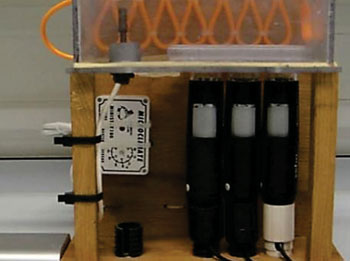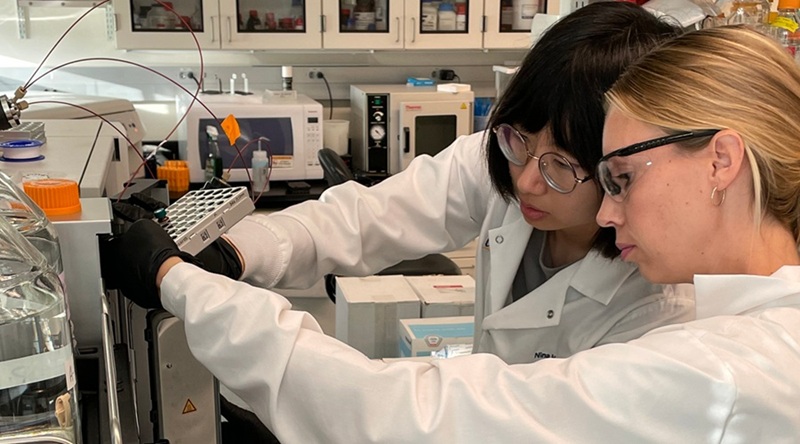High-Tech Microscope Constructed for Low Cost
|
By LabMedica International staff writers Posted on 08 Dec 2014 |

Image: The low cost microscope system constructed to perform multiple simultaneous time-lapse studies on various cell types (Photo courtesy of Adam Lynch).
The direct visualization of cells for the purpose of studying their motility has typically required expensive microscopy equipment; however, recent advances in digital sensors mean that it is now possible to image cells for a fraction of the price of a standard microscope.
The development and performance of an expandable cell motility system has been described that employs inexpensive, commercially available digital Universal Serial Bus (USB) microscopes to image various cell types using time-lapse and perform tracking assays.
Scientists at Brunel University (Uxbridge, UK) constructed the apparatus from cheaply bought materials. Various lighting sources were tested, and ultimately a light-emitting diode (LED) strip desk lamp was selected. An incubation chamber was developed to fit over the top of the stage and the chamber was made from transparent acrylic to allow visualization inside.
The three microscopes used were identical models (VMS-004D, Veho; Southampton, UK) in order to prevent any discrepancies. These microscopes use a complementary metal–oxide–semiconductor (CMOS) image sensor with 1.3 mega-pixel resolution. Magnification has two set levels, from approximately ×20 minimum to around ×400 maximum, achieved using a focusing wheel. To enhance stability, magnification and to allow for observation of live samples in liquid (cells) the microscopes were inverted.
The imaging capability of the system was compared to a conventional inverted microscope fitted with a 1.3 megapixel camera. The highest magnification on the conventional microscope was greater than the constructed system, but the maximum pixel resolution of images was the same. Spatial resolution on the conventional microscope was higher and intra-cellular detail could be seen at the highest magnification that could not be distinguished in the innovative system when images were enlarged to match the size.
The authors concluded that the novel cell tracking system had the ability to perform multiple simultaneous time-lapse studies on various cell types. Due to its low-cost, portability and commercially available components they believe that this system has the potential to enable time-lapse studies by non-specialist departments, and may be a practical solution for scientists with limited financial resources. The study was published on August 14, 2014, in the journal Public Library of Science ONE.
Related Links:
Brunel University
Veho
The development and performance of an expandable cell motility system has been described that employs inexpensive, commercially available digital Universal Serial Bus (USB) microscopes to image various cell types using time-lapse and perform tracking assays.
Scientists at Brunel University (Uxbridge, UK) constructed the apparatus from cheaply bought materials. Various lighting sources were tested, and ultimately a light-emitting diode (LED) strip desk lamp was selected. An incubation chamber was developed to fit over the top of the stage and the chamber was made from transparent acrylic to allow visualization inside.
The three microscopes used were identical models (VMS-004D, Veho; Southampton, UK) in order to prevent any discrepancies. These microscopes use a complementary metal–oxide–semiconductor (CMOS) image sensor with 1.3 mega-pixel resolution. Magnification has two set levels, from approximately ×20 minimum to around ×400 maximum, achieved using a focusing wheel. To enhance stability, magnification and to allow for observation of live samples in liquid (cells) the microscopes were inverted.
The imaging capability of the system was compared to a conventional inverted microscope fitted with a 1.3 megapixel camera. The highest magnification on the conventional microscope was greater than the constructed system, but the maximum pixel resolution of images was the same. Spatial resolution on the conventional microscope was higher and intra-cellular detail could be seen at the highest magnification that could not be distinguished in the innovative system when images were enlarged to match the size.
The authors concluded that the novel cell tracking system had the ability to perform multiple simultaneous time-lapse studies on various cell types. Due to its low-cost, portability and commercially available components they believe that this system has the potential to enable time-lapse studies by non-specialist departments, and may be a practical solution for scientists with limited financial resources. The study was published on August 14, 2014, in the journal Public Library of Science ONE.
Related Links:
Brunel University
Veho
Latest Technology News
- Machine Learning Models Diagnose ALS Earlier Through Blood Biomarkers
- Artificial Intelligence Model Could Accelerate Rare Disease Diagnosis
- AI Saliva Sensor Enables Early Detection of Head and Neck Cancer
- AI-Powered Biosensor Technology to Enable Breath Test for Lung Cancer Detection
- AI Model Achieves Breakthrough Accuracy in Ovarian Cancer Detection
- Portable Biosensor Diagnoses Psychiatric Disorders Using Saliva Samples
- Cell-Sorting Device Uses Electromagnetic Levitation to Precisely Direct Cell Movement

- Embedded GPU Platform Enables Rapid Blood Profiling for POC Diagnostics
- Viral Biosensor Test Simultaneously Detects Hepatitis and HIV
- Acoustofluidic Device to Transform Point-Of-Care sEV-Based Diagnostics
- AI Algorithm Assesses Progressive Decline in Kidney Function
Channels
Clinical Chemistry
view channel
Online Tool Detects Drug Exposure Directly from Patient Samples
Doctors often rely on patient interviews and medical records to determine what medications a person has taken, but this information is frequently incomplete. People may forget drugs they used, take over-the-counter... Read more
Chemical Imaging Probe Could Track and Treat Prostate Cancer
Prostate cancer remains a leading cause of illness and death among men, with many patients eventually developing resistance to standard hormone-blocking therapies. These drugs often lose effectiveness... Read moreMolecular Diagnostics
view channel
New 15-Minute Hepatitis C Test Paves Way for Same-Day Treatment
Chronic hepatitis C infection affects an estimated 50 million people worldwide and causes around 242,000 deaths each year, largely due to cirrhosis and liver cancer. Although the infection is curable with... Read more
Ovarian Cancer Assay Outperforms Traditional Tests in Early Disease Detection
Globally, ovarian cancer is one of the deadliest cancers affecting women. Traditionally, early diagnosis of ovarian cancer has been challenging. Many ovarian cancers are diagnosed only after they have... Read moreHematology
view channel
MRD Tests Could Predict Survival in Leukemia Patients
Acute myeloid leukemia is an aggressive blood cancer that disrupts normal blood cell production and often relapses even after intensive treatment. Clinicians currently lack early, reliable markers to predict... Read more
Platelet Activity Blood Test in Middle Age Could Identify Early Alzheimer’s Risk
Early detection of Alzheimer’s disease remains one of the biggest unmet needs in neurology, particularly because the biological changes underlying the disorder begin decades before memory symptoms appear.... Read more
Microvesicles Measurement Could Detect Vascular Injury in Sickle Cell Disease Patients
Assessing disease severity in sickle cell disease (SCD) remains challenging, especially when trying to predict hemolysis, vascular injury, and risk of complications such as vaso-occlusive crises.... Read more
ADLM’s New Coagulation Testing Guidance to Improve Care for Patients on Blood Thinners
Direct oral anticoagulants (DOACs) are one of the most common types of blood thinners. Patients take them to prevent a host of complications that could arise from blood clotting, including stroke, deep... Read moreImmunology
view channel
Routine Blood Test Can Predict Who Benefits Most from CAR T-Cell Therapy
CAR T-cell therapy has transformed treatment for patients with relapsed or treatment-resistant non-Hodgkin lymphoma, but many patients eventually relapse despite an initial response. Clinicians currently... Read more
New Test Distinguishes Vaccine-Induced False Positives from Active HIV Infection
Since HIV was identified in 1983, more than 91 million people have contracted the virus, and over 44 million have died from related causes. Today, nearly 40 million individuals worldwide live with HIV-1,... Read more
Gene Signature Test Predicts Response to Key Breast Cancer Treatment
DK4/6 inhibitors paired with hormone therapy have become a cornerstone treatment for advanced HR+/HER2– breast cancer, slowing tumor growth by blocking key proteins that drive cell division.... Read more
Chip Captures Cancer Cells from Blood to Help Select Right Breast Cancer Treatment
Ductal carcinoma in situ (DCIS) accounts for about a quarter of all breast cancer cases and generally carries a good prognosis. This non-invasive form of the disease may or may not become life-threatening.... Read moreMicrobiology
view channel
Blood-Based Diagnostic Method Could Identify Pediatric LRTIs
Lower-respiratory tract infections (LRTIs) are a leading cause of illness and death worldwide, and pneumonia is the leading infectious cause of death in children under five, claiming the lives of over... Read more
Rapid Diagnostic Test Matches Gold Standard for Sepsis Detection
Sepsis kills 11 million people worldwide every year and generates massive healthcare costs. In the USA and Europe alone, sepsis accounts for USD 100 billion in annual hospitalization expenses.... Read moreRapid POC Tuberculosis Test Provides Results Within 15 Minutes
Tuberculosis remains one of the world’s deadliest infectious diseases, and reducing new cases depends on identifying individuals with latent infection before it progresses. Current diagnostic tools often... Read more
Rapid Assay Identifies Bloodstream Infection Pathogens Directly from Patient Samples
Bloodstream infections in sepsis progress quickly and demand rapid, precise diagnosis. Current blood-culture methods often take one to five days to identify the pathogen, leaving clinicians to treat blindly... Read morePathology
view channel
Rapid Low-Cost Tests Can Prevent Child Deaths from Contaminated Medicinal Syrups
Medicinal syrups contaminated with toxic chemicals have caused the deaths of hundreds of children worldwide, exposing a critical gap in how these products are tested before reaching patients.... Read more
Tumor Signals in Saliva and Blood Enable Non-Invasive Monitoring of Head and Neck Cancer
Head and neck cancers are among the most aggressive malignancies worldwide, with nearly 900,000 new cases diagnosed each year. Monitoring these cancers for recurrence or relapse typically relies on tissue... Read more
Common Health Issues Can Influence New Blood Tests for Alzheimer’s Disease
Blood-based tests for Alzheimer’s disease are transforming diagnosis by offering a simpler alternative to spinal taps and brain imaging. However, many people evaluated at memory clinics also live with... Read more
Blood Test Formula Identifies Chronic Liver Disease Patients with Higher Cancer Risk
Chronic liver disease affects millions worldwide and can progress silently to hepatocellular carcinoma (HCC), one of the deadliest cancers globally. While surveillance guidelines exist for patients with... Read moreIndustry
view channel
Abbott Acquires Cancer-Screening Company Exact Sciences
Abbott (Abbott Park, IL, USA) has entered into a definitive agreement to acquire Exact Sciences (Madison, WI, USA), enabling it to enter and lead in fast-growing cancer diagnostics segments.... Read more









 assay.jpg)







